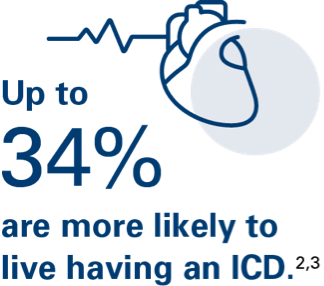Learn About ICD Options
If your doctor has recommended an implantable cardiac defibrillator (ICD) for you, you’ll have a couple of decisions to make. First, do you want to get a device? And if so, which type of device? This page and conversations with your doctor can help you learn more. So together you can make the right decision for you.
This process is called Shared Decision Making. To learn more about what Shared Decision Making means for you as a patient, click here to watch a 30-minute educational program on this topic offered by Mended Hearts. Mended Hearts is the nation’s premier peer-support program for patients who have cardiovascular disease, their caregivers, and their families.
Only 1 in 10 people who have sudden cardiac arrest outside the hospital without an ICD survive.1 With an ICD >95% live.2,3 |
How does an ICD work?
Can an ICD prolong my life?In studies of people at risk for sudden cardiac arrest, those with an ICD were 23%–34% more likely to live compared to people without an ICD.2,3 |
 |
What are the options?
If you choose to get an ICD, you have two options from Boston Scientific: subcutaneous (S-ICD) and transvenous (TV-ICD). The main difference between the two devices is where the lead – that’s the wire that will deliver the shock to your heart – is placed. With a TV-ICD, the lead is placed inside the heart. Our S-ICD’s lead does not touch the heart; it is placed under the skin on your chest.
Want to learn more about the different ICDs?
Will the ICD be visible?
TV-ICD




S-ICD


Hear how other people made the decision.
Haven’t talked to your doctor yet?

Find a Doctor
Find an electrophysiologist in your area trained and experienced in the cutting-edge EMBLEM MRI S-ICD technology.
Hear from S-ICD System patients
Meet real S-ICD System patients as they share their stories and personal journeys.










